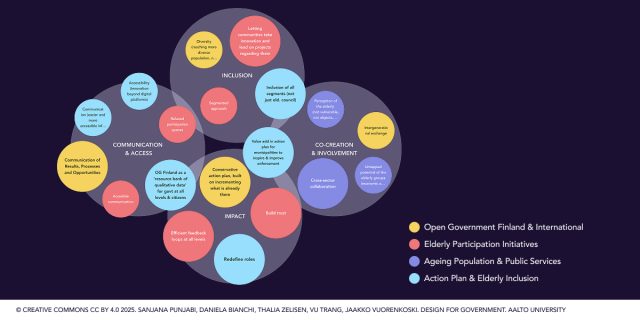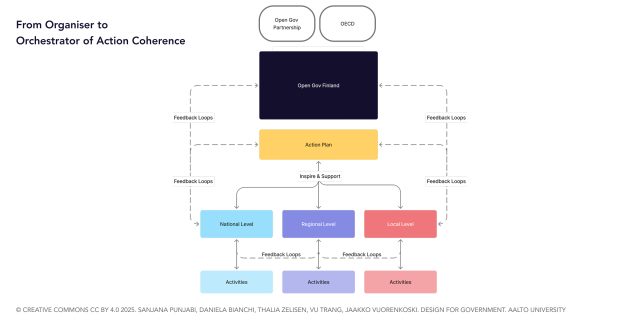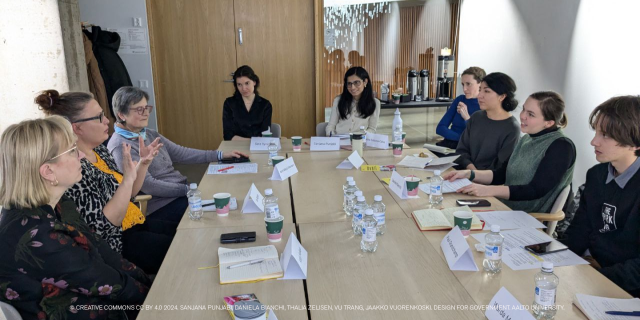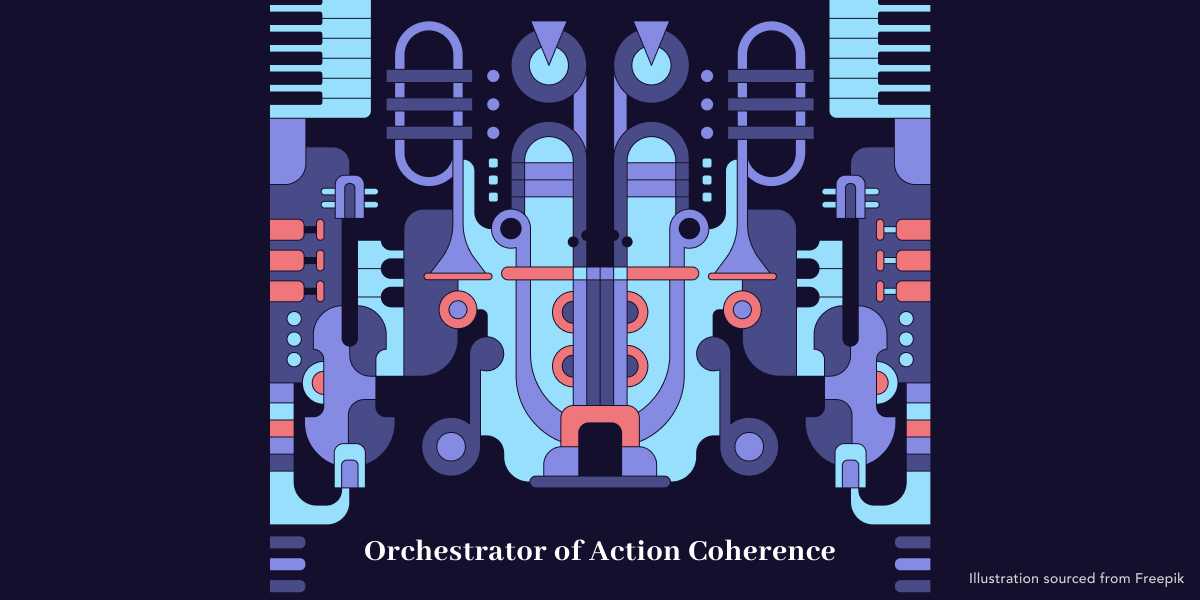This blog post reports on work-in-progress within the DfG course! The post is written by group 1 dealing with the Ministry of Finance’s brief on ‘Open Governance’. The group includes Sanjana Punjabi from the Collaborative and Industrial Design program (Aalto Arts), Daniela Bianchi from the Collaborative and Industrial Design program (Aalto Arts), Vu Trang from the Sustainable Entrepreneurship program (Aalto BIZ), Thalia Zelißen (TU Munich) from the Environmental Engineering Program and Jaakko Vuorenkoski from Information and Service Management program (Aalto BIZ).
Written by: Sanjana Punjabi
After three weeks of research, the Open Government’s four workstreams presented their findings to each other. We then gathered as a supergroup to map out our insights, searching for connections between them. The guiding question for our mapping exercise was: What does meaningful participation mean to different stakeholders? We chose this focus because participation is often seen as a checkbox in governance processes, but when done meaningfully, it can serve as a powerful driver of trust, collaboration, and action.
Our findings highlighted these crucial concepts: solidarity, empathy, efficient feedback loops, impact, awareness, transparency, and mutual respect. This laid the foundation for the next phase of our project. After this first stage of research, the ten of us were then split into two groups to work on our research further.
Thematic Analysis of Insights

Figure 1: Thematic Analysis of Workstream Insights
In our group, each member brought insights from their respective workstreams, as shown above. This allowed us to identify overlaps, spot gaps, and build a more holistic understanding of the open government landscape. Through discussion, we categorised these insights into four key themes:
- Inclusion of diverse groups in open governance,
- Co-creation and involvement of local, regional, and national governments alongside civil society and citizens,
- Establishing efficient feedback loops among co-creators to drive impact
-
Ensuring communication and accessibility of results, processes, and opportunities within open government initiatives and independent group efforts.
Shifting Focus: From Fragmentation to Orchestration
Our initial project brief focused on addressing the needs of Finland’s ageing population. However, after analysing the broader landscape of open government, elderly citizen councils at regional and municipal levels, and the elderly population itself, we recognised that open government initiatives are already highly active despite limited resources. These organisations engage diverse stakeholders, including government bodies and citizens, through various initiatives. However, collaboration between them remains fragmented.
Rather than solely concentrating on the elderly population or creating new networks, we identified an opportunity to strengthen and optimise existing ones. This realisation led us to refine our project brief:
From: How can the Open Government Action Plan 2023–2027 better address the needs of Finland’s ageing population?
To: How can redefining the roles of all stakeholders transform Open Government into an orchestrator of action coherence?
This shift reframes Open Government Finland as a key facilitator, ensuring that insights from diverse stakeholders translate into meaningful actions at different levels.
Understanding Action Coherence: What Does It Mean?
According to our group, action coherence refers to the ability to align efforts across different stakeholders in a way that maximises efficiency, minimises redundancy, and drives meaningful impact. In the context of Open Government, this means ensuring that national and local governments, civil society organisations, and communities are not working in isolation but are instead strategically coordinated.

Figure 2: Our understanding of action coherence through feedback loops
To understand action coherence, we are studying Open Government as a system. We would like to examine how stakeholders interact, where information flows or gets lost, and how feedback loops can be structured for better alignment across different governance levels .(Meadows, 1999).
Key Research Questions
To explore this new direction, we established three guiding research questions:
- How can agencies, municipalities, and civil society collaborate more effectively through responsible feedback loops?
- What would an updated stakeholder map look like to reflect evolving roles and relationships?
- What tangible value can municipalities gain from more active participation in the Open Government Action Plan?
As one of our team members put it: “Redefining roles isn’t just about clarity, it’s about empowerment. When stakeholders understand their contributions, participation becomes more impactful.”So we decided to explore how Open Government can facilitate more effective, collaborative, and empowering forms of participation.
Redefining Roles for Empowerment
This shift in perspective led us to examine real-world interactions within Open Government to see how these dynamics play out. Currently, Open Government Finland collects valuable qualitative data through initiatives like National Dialogues, Civil Society Academy, Open Government Network and Elderly Citizen Council Day.

Figure 3: Round Table Discussion
During our roundtable discussion with two important members from the Ministry of Finance, Katju Holkeri and Ira Alanko, and, the chairman of the Elderly Citizens’ Council in Helsinki, Auni-Marja Vilavaara, we learned about the Elderly Citizens’ Councils Day. This annual event gathers representatives from elderly councils and NGOs across Finland, both in person and online. It is a strong initiative that encourages dialogue around a theme set by Open Government. However, a major gap exists. Despite the valuable discussions at the Elderly Citizens’ Councils Day, there’s no structured way to share these insights. Without a central platform to communicate key takeaways, many valuable discussions risk being forgotten rather than turned into action.

Figure 4: Civil Society Academy Day
To better understand the situation, a few members of our supergroup attended the Civil Society Academy Day on March 26, 2025—an event aimed at strengthening relationships between public administration and civil society organisations. The discussions focused on building a crisis-resilient society, featuring insights from the Finnish Red Cross and Pekka Haavisto, a former Finnish minister and diplomat, on peace mediation. One key takeaway from this event was the diversity of participating organisations, both governmental and non-governmental, and the range of perspectives they brought to the discussions. A noticeable gap was the absence of representatives from elderly organisations and other marginalised groups. A member of a youth organisation was actively engaged in the discussions, but voices from other vulnerable communities were missing.
When our teammates reflected on the event, it became clear that the discussions held there were highly relevant—not just for the organisations present but for a much broader audience. For example, they discussed the role of empathy in building societal trust. In times of crisis, having strong local connections and knowing your neighbours can create a support system. They also stressed the importance of knowing the right people and organisations to turn to for security and assistance.
In our team, we discussed how as immigrants in Finland, we would not know who to reach out to during a crisis. Additionally, since much of this information is available only in Finnish, language becomes another barrier. Interestingly, even students who are Finnish citizens admitted that they, too, were unsure of the right points of contact in an emergency. This highlights a crucial issue: discussions like these should not be confined to civil society organisations alone. Their insights must be accessible to a wider audience.
This observation ties into our exploration of action coherence. Many meaningful conversations and knowledge exchanges already take place, and there is potential to amplify their impact by ensuring broader access and engagement. By moving beyond data collection, open government can transition into an orchestrator, ensuring that insights inform a more dynamic and accountable governance system. They can take a more active role in interpreting and translating this data into actionable strategies for municipalities and civil society organisations.
One key opportunity lies in establishing structured collaboration frameworks, where stakeholders regularly convene to discuss progress, challenges, and opportunities for joint action. These could take the form of facilitated working groups or digital platforms that enhance transparency and coordination.
Next Steps: Deepening Our Research
Our midterm presentation provided further avenues for exploration, including political engagement, re-looking at hierarchical organisational structures, and the balance between participation and decision-making. To continue our research, we plan to:
- Conduct in-depth interviews with key stakeholders, including Open Government Finland, the municipalities of Helsinki and Oulu, rural governance representatives, and elderly council members.
- Attend relevant events to observe participation dynamics in action.
- Perform desktop research on citizen surveys and the role of meaningful participation in governance.
- Analyse the operational model and where this action coherence gets lost in this model.
Our journey so far has shown us that participation is not just about being invited to the table, it’s about ensuring that voices lead to action. As we move forward, we’ll continue exploring how Open Government can not only facilitate dialogue but also ensure coherence in action.
Stay tuned!
References
Meadows, D. (1999). Leverage Points: Places to Intervene in a System. Leverage Points: Places to Intervene in a System. https://donellameadows.org/archives/leverage-points-places-to-intervene-in-a-system/
The DfG course runs for 14 weeks each spring – the 2025 course has now started and runs from 24th Feb to 27th May. It’s an advanced studio course in which students work in multidisciplinary teams to address project briefs commissioned by governmental ministries in Finland. The course proceeds through the spring as a series of teaching modules in which various research and design methods are applied to address the project briefs. Blog posts are written by student groups, in which they share news, experiences and insights from within the course activities and their project development. More information here about the DfG 2025 project briefs. Hold the date for the public finale on Tuesday 27th May!

